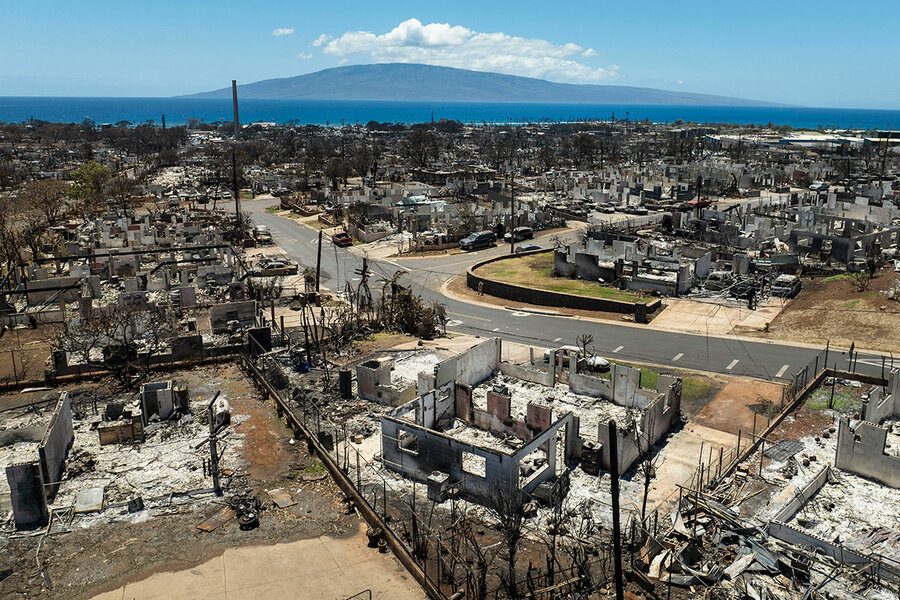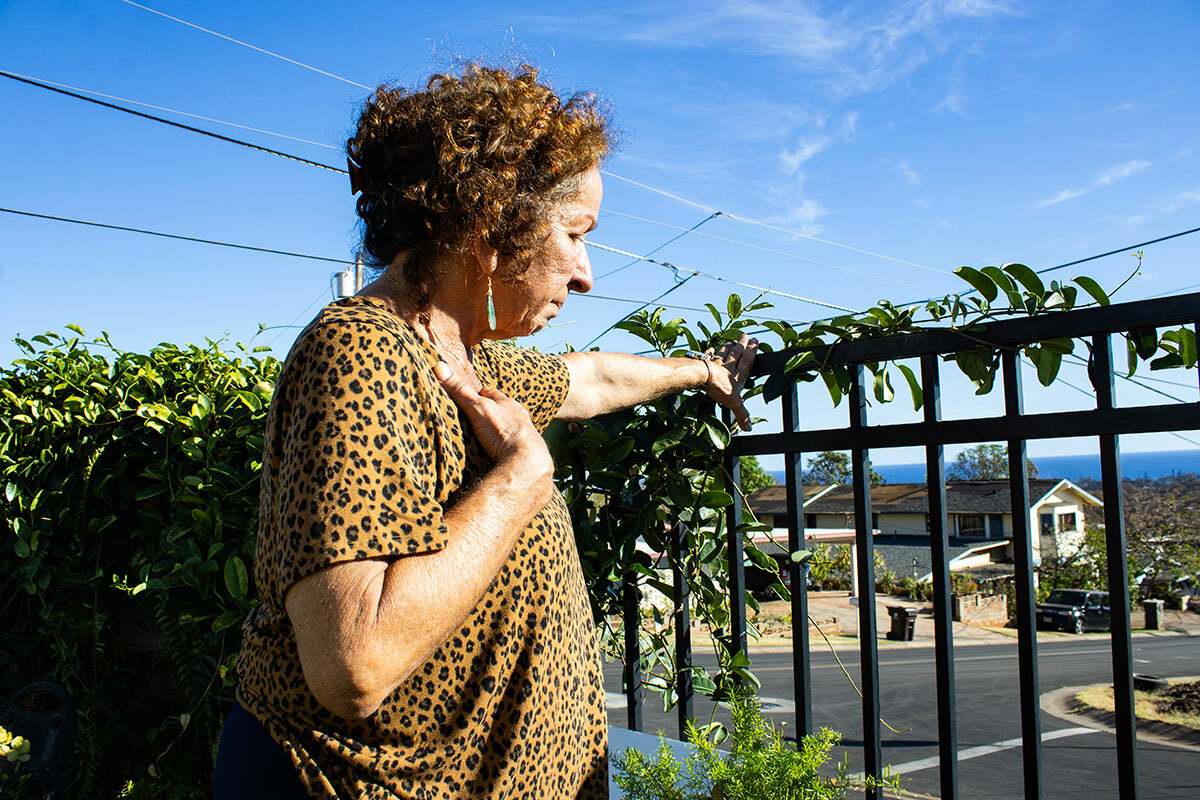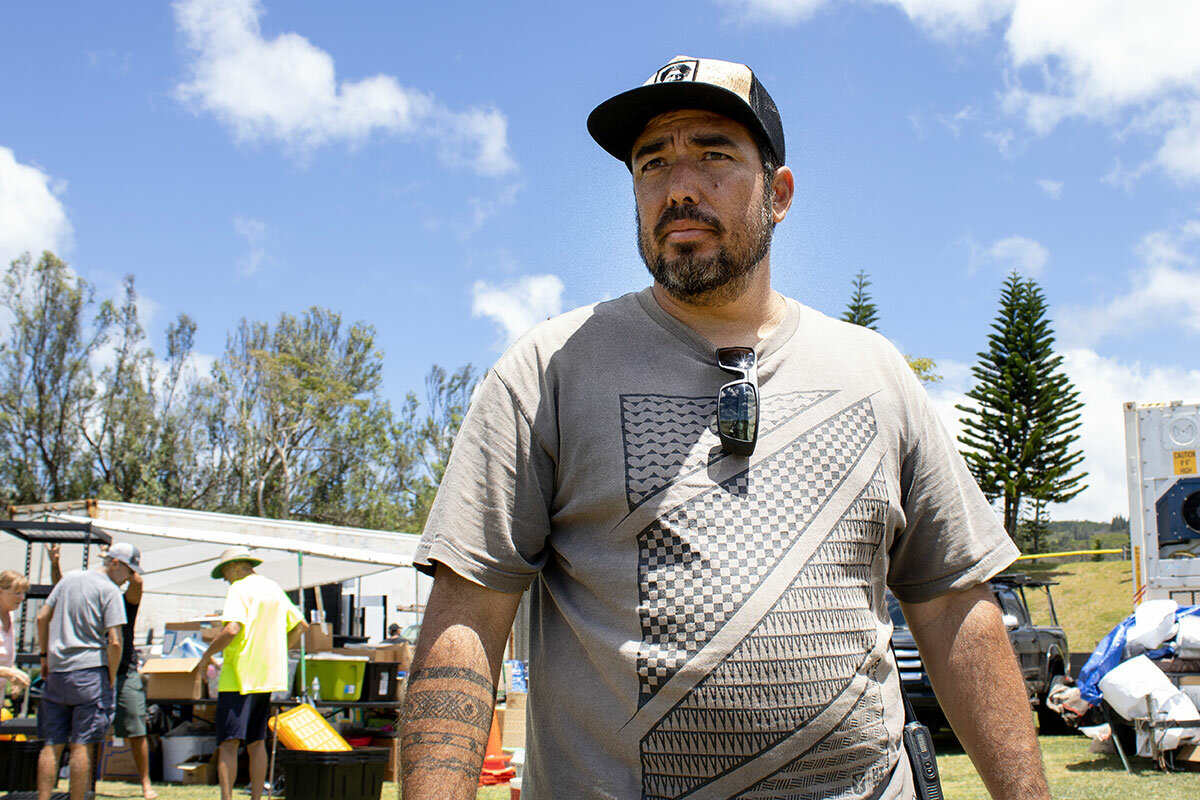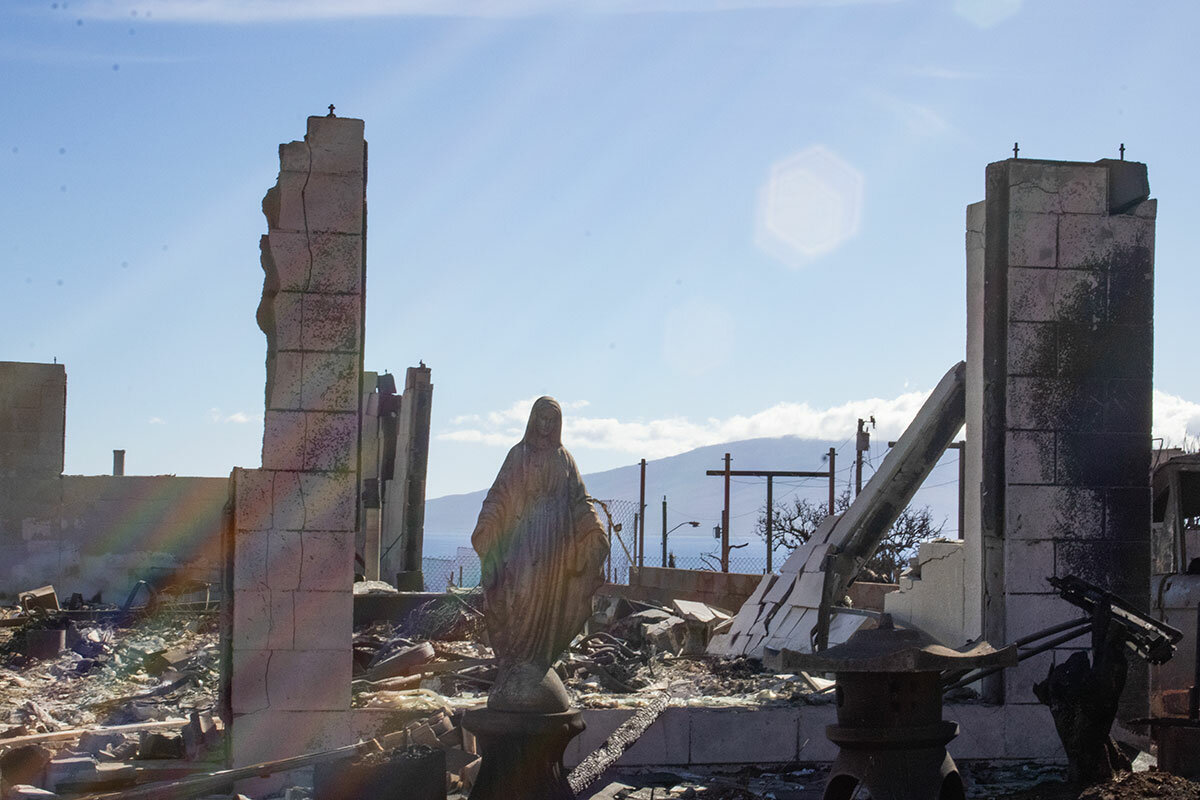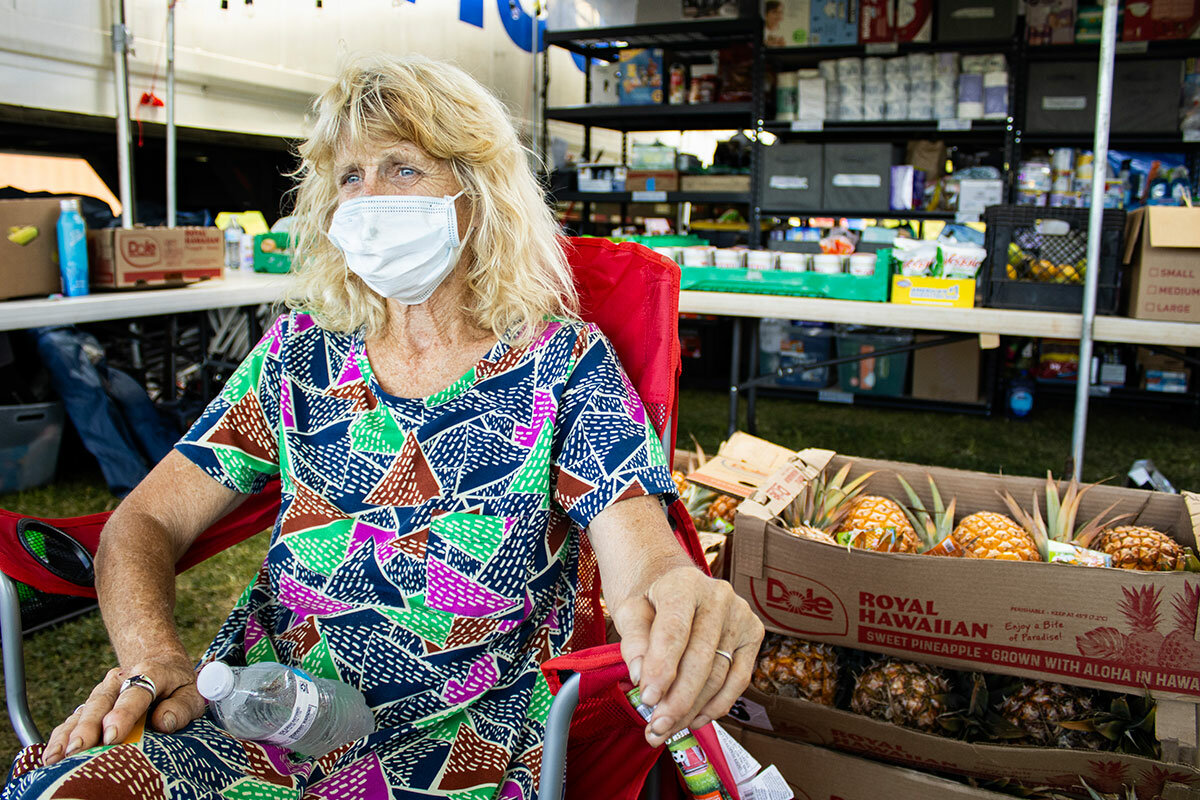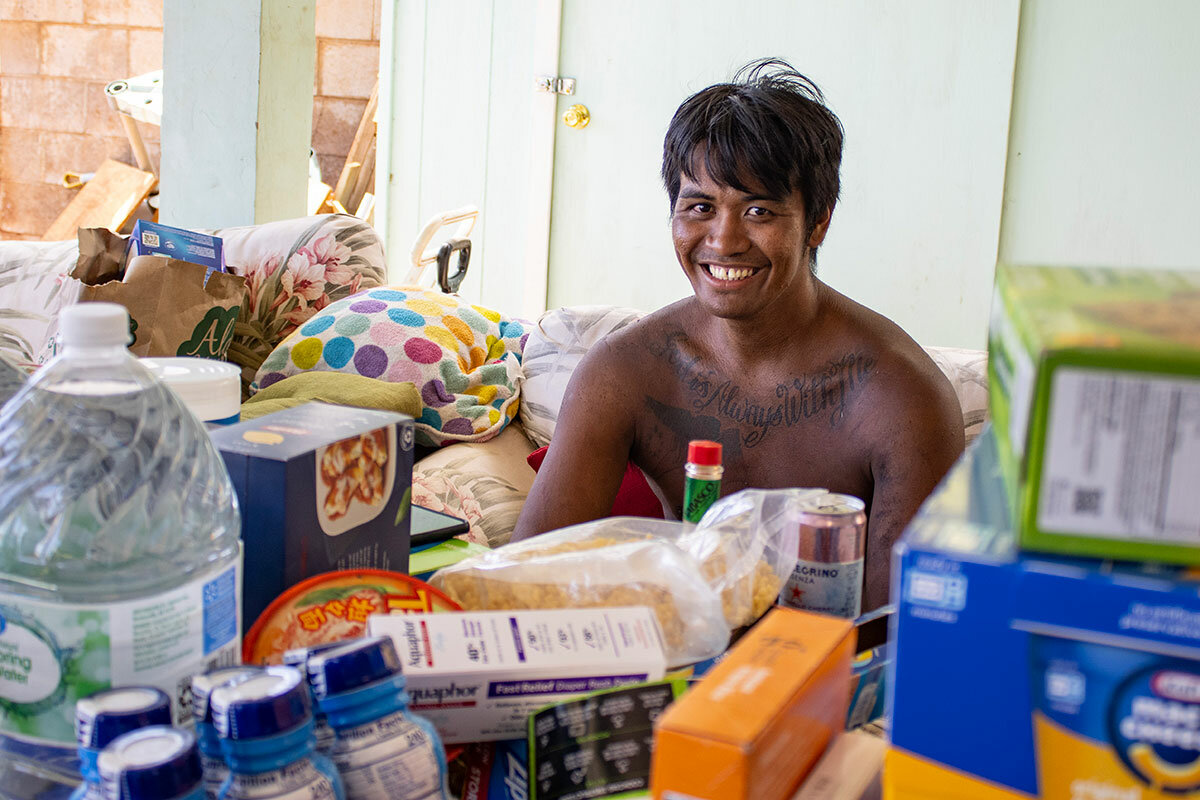Tracing Lahaina’s story, from royal kingdom to fiery blaze
Loading...
| Lahaina, Hawaii
From her backyard fence, Cindy Williams takes in the town where she was born and raised. Not even wildfire could make her leave Lahaina.
Etched into the hillside behind her is a large letter L, whitened with lime by students at her alma mater, Lahainaluna High School. Below her is the spindly smokestack of the Pioneer Mill Co., recalling an era that lured her Portuguese grandparents with jobs in sugar cane.
But some landmarks are missing from the scene since an Aug. 8 wildfire, the most destructive of multiple blazes that ignited on Maui, Hawaii, that day. Gone is the Waiola Church, where her husband’s family pastored. Gone are hotels and stores. The fangs of flames devoured houses just a few blocks from her. Sometimes it’s hard for Ms. Williams to look.
Why We Wrote This
A story focused onLahaina, a historic town and community burned by a wildfire on Maui, has seen upheavals and fresh starts before. Now residents face a new era of renewal following the fire.
The story of Lahaina is one of transformation – from a place of Native royalty to one of missionaries, sugar moguls, and the tourists who fled this month. Transformation also runs through the roots of Lahaina family trees, generations that have loved and lost, left and stayed, worked and worshipped here.
The deadliest U.S. wildfire in more than a century, with 115 confirmed dead to date, has transformed this place again. No one knows what fruit the seeds of recovery will bear, but those who love Lahaina intend to plant them.
“I want it to look and stay like the Lahaina town that we know,” says Ms. Williams. “The cultural essence and the local history of it, the community helping each other.”
That’s what she’s doing now, transforming her garage into a depot of donations for neighbors. People can come by for noodle packets, canned goods, or a smile.
Sacred land
Discussion of the tragedy often involves the legacy of land, which Native Hawaiians hold sacred.
“We start our histories with the landscape,” says Davianna Pomaikai McGregor, retired professor of ethnic studies at the University of Hawaii at Manoa. “It’s the akua,” or deities, “our natural elements, endowing the land with its features and its resources.”
The fire represents a hulihia, an overturning, she says. The professor points to a disturbance in nature that began long ago – the transformation of wetlands into stretches of fallow cash-crop fields today.
It’s a scene far different from what met Maui’s first explorers by canoe. Among the plants they brought were breadfruit, whose groves later graced Lahaina with shade.
Capital of the Hawaiian Kingdom
Centuries after Polynesians settled the Hawaiian Islands, the district of Lahaina served as the capital of the Hawaiian Kingdom during the first half of the 19th century.
A range of factors – including its home to sacred sites, waterways, and access to fisheries – helped secure Lahaina’s status. During that period, the kingdom was recognized as sovereign through a proclamation by Great Britain and France.
Kaipo Kekona wears that Independence Day date – Nov. 28, 1843 – on a baseball cap. It shields him from the sun in spacious Napili Park, north of the Lahaina wreckage.
The Native Hawaiian, among those who don’t consider themselves American, coordinates one of several mutual aid efforts separate from the government. For many residents of the islands, the overthrow of the Hawaiian Kingdom and then annexation still color their perception of the U.S. government.
“We are capable of caring for ourselves,” says Mr. Kekona, directing volunteers in a field.
The landing at Lahaina, today known as the town harbor, offered a gateway for the kingdom’s travel and largely agricultural trade. Inland, Native Hawaiians cultivated fishponds, and an intricate irrigation system called auwai – channels and canals – watered taro patches. The plant with heart-shaped leaves features in the Hawaiian creation story and served as a staple of the Native diet.
Missionaries arrive
Customs began to change over the ensuing decades with new arrivals. New England missionaries started to appear around the 1820s. Their gospel so moved Queen Keopuolani that she founded what would become known as the Waiola Church, just behind the royal seat of the kingdom.
Though razed by the recent fire, the building has a history of resurrection from multiple disasters. An 1894 account of a blaze that year reads: “A Bible, the sacred vessels and a harmonium were saved, but the property was demolished.”
Linda Norrington is “confident” the house of worship will rise again, even if it takes years. The church moderator recalls how, during open-door services, she could hear the songs of birds. One flew in and landed on the altar.
“It felt like you were in God’s presence,” she says.
As perspectives of faith transformed in the 1800s, so did the use of land. Ground held by Native Hawaiian families was increasingly sold, leased, or taken by large-scale producers of sugar cane and pineapple grown for economic profit.
Plantation era
The Pioneer Mill Co., which ran from 1860 to 1999 producing sugar, drew not just immigrants from around the world but greater thirst for water to cultivate crops. One historical report from a Lahaina committee, created to investigate the cause of famine in 1867, largely blamed the expansion of the sugar industry along with the loss of traditional farming and natural-resources stewardship.
“God is not the reason for this lack, nor is it because there is a lack of rain – instead it is the lack of thought by men,” reads a translated section, from Hawaiian to English, by ethnographer Kepa Maly. The last of Maui’s plantations, which helped grow the island’s economy, closed in 2016 due to labor and transportation costs.
Land use is much discussed as context of the Aug. 8 Lahaina fire, whose cause remains under investigation. The county of Maui, meanwhile, has sued Hawaiian Electric, alleging that the utility was negligent in failing to shut off power under dry and high-wind weather. The power company acknowledged that downed power lines appear to have started a fire that morning, to which firefighters responded. The company laid further blame with the county, calling the lawsuit “factually and legally irresponsible” and claiming it had de-energized power lines before another fire began in the afternoon.
Backdropped by a warming climate, many Maui residents and experts also point to ongoing commodification of land and water as having created tinderbox conditions in Lahaina, where former plantation fields lie fallow and are often covered with highly flammable nonnative grasses.
Shelley Polson used to let her dogs run through those empty acres.
She found one of them, Shadow, after the fire. But Rebel is still lost.
Tourist haven – and home
Under a tent in Napili Park, Ms. Polson sits beside boxes of pineapples. Originally from British Columbia, Ms. Polson moved to Lahaina about 40 years ago.
“It just looked like my hometown, and everything was warm,” she says. “I made some really good friends through the years.” Her roommate is among those who died.
For years Ms. Polson worked at a gift shop in a commercial strip close to the ocean. Nearby grew the sprawling 150-year-old banyan tree, scorched but still standing, where people could gather under its branches to eat rainbow-colored shave ice. Christina Nakihei, who went to high school here, worked at a fudge shop close by.
“Everyone is looking out for everyone” in Lahaina, says Ms. Nakihei, who now lives in Seattle. “Community members would stop and say, ‘Hey, do you want a ride?’”
Lahaina, along with nearby areas of West Maui, in 2022 contributed $2.9 billion of visitor expenditures – 15% of the state total. Now, however, visiting is discouraged as ashen rubble remains, and residents are wary of land grabs by outsiders.
Lahaina resident Raynard Delatori, who evacuated but whose home was spared, has already felt disrespected. The week following the fire, Mr. Delatori says he received two calls from unknown parties asking if he wanted to sell.
“For me, it’s like, seriously?” says Mr. Delatori. “At this time?”
Since then, an emergency proclamation signed by Democratic Gov. Josh Green makes it a crime to offer an unsolicited bid to a property owner located in certain Maui ZIP codes. Affordable housing is tight on the island, as it is across the state. The median sale price of a Lahaina home last month was $1 million, according to tracking by Redfin.
At the same time, the governor has also appealed to tourists to keep vacationing in Hawaii – while avoiding West Maui. But the thought of tourism now, and its role in recovery, is difficult for some Hawaii residents to embrace.
Some tourists empathize. “I understand that,” says Ed Beykovsky in Kihei, south of Lahaina, as he pauses his vacation to help.
The visitor from Oregon unloads a car of diapers, baby formula, and two-way radios that his family bought to ship to those in need by boat – one of multiple trips. The weekend before the fire, he and his wife, Kathy, had gotten breakfast in Lahaina, his sixth trip to the town. He’s now back home.
What will recovery look like?
It’s unclear what version of Lahaina Mr. Beykovsky and others might encounter in future years, much less what awaits locals when rebuilding is complete. For now, grief runs deep.
“There’s this contention between real estate development versus returning the land” to more traditional uses like farming, says Dr. McGregor, the ethnic studies professor. “What vision will prevail?”
For now, a vision of neighborly care. In a mint-green house a few blocks from Ms. Williams, Steve McQueen has stockpiled goods to distribute, too. Quick to smile and offer water, he stayed behind to help others who remain.
“I cannot leave them,” he says.
Neither has he left the doves, the ones in his driveway. A neighbor used to feed them, but that house burned. Now the birds have nowhere to go, Mr. McQueen explains.
That’s why, each day, he brings them bread and oats.




